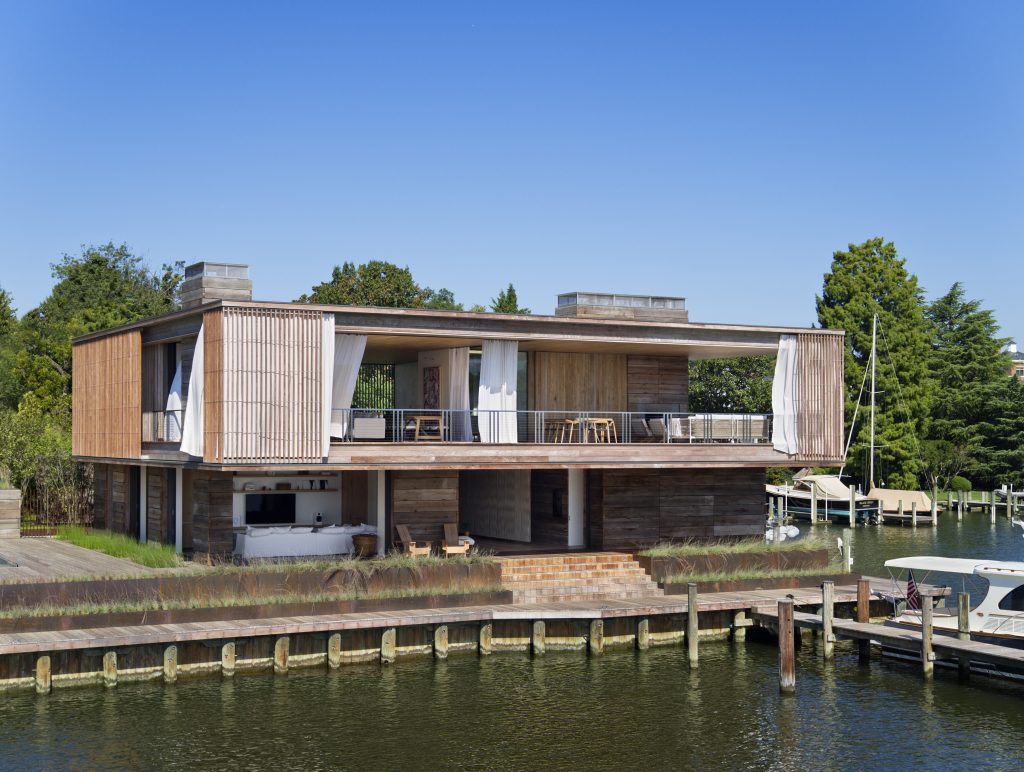- © 2024 Annapolis Home Magazine
- All Rights Reserved
By Robert Haywood | Photography by Michael Moran

Acton Cove
Acton Cove is the most radical residential architecture in Annapolis. With its minimal elegance and open walls (yes, that is an oxymoron, but more on this point later), the home is unlike any other waterfront design in the city. Rightly so, the home, designed by Bates Masi + Architects in East Hampton, New York won the American Institute of Architects Honor Award for the Chesapeake Bay Region, the highest award for residential architecture. The jurors for the competition noted that this contemporary home “respond[s] to the vernacular site…with its form, layering and selection of materials. The clean lines and purity in form pays homage to the boating heritage found adjacent to this waterfront site.”
The home replaces a residence from the 1970s built on a small lot presiding over Acton Cove on
Spa Creek. While a private home, the new structure, with its prominent location on the cove, is also public in that it effectively redefines the waterfront, giving it a signature contemporary flair. Bates Masi points out that the pre-existing house did not meet the homeowners’ needs, but its bulkheads and docks offered the chance to build a home just steps from the water in downtown Annapolis. Bates Masi explains that as “the previous house was demolished, layer upon layer of old bulkheads and fill revealed how generations of previous owners had expanded the site into the harbor and reinforced it from the elements.” The process of layering inspired the home’s design so that the plan “configures layers of site features and envelope elements to provide privacy and weather protection, while encouraging connections to the outdoors.”
With its open design, this home welcomes the outdoors and water. While walls are constructed to enclose a home, protect the interior space from the elements and reinforce a home’s privacy, these walls disappear, leaving only the frame intact. Large expanses of glass are retractable and slide into adjacent walls allowing for a complete merging of indoor and outdoor spaces. The pocket glass walls, or “frameless sliding doors” as described by the manufacturer Sky-Frame, also provide the option for insect screens.
Deep overhangs provide shade on the upper and lower levels. The second floor, which houses the kitchen, living area, and master bedroom and bath, is wrapped in rows of fixed ipe screens and operable canvas drapes, providing privacy for the master balcony and shade for the outdoor dining area. The judges noted that all this layering effect and modifiable open and enclosed space are so effective that it took them “a while to determine what spaces were interior versus exterior.”
Other notable features of this home are its use of reclaimed wood and green roof. The ambitious architectural plans required an experienced and skilled custom builder to turn the plans into a livable three-dimensional structure. That builder was Pyramid Builders in Annapolis, whose craftsmanship is evident everywhere.
Gregg Bleam, who teaches landscape architecture at the University of Virginia, designed the exterior grounds. The outermost layer of the property is the bulkhead, on top of which is a boardwalk of ipe decking on three sides, which connects to the several docks. On the harbor side, weathering Corten steel walls create a transition from the lower level to the dock. The wall planters support Spartina marsh grass, often found in intertidal wetlands.
As the architects indicate, the many layers of this home respond to the physical layers of history and marine life as it maximizes the experience of waterfront living. This bold contemporary residence, with its precise lines, flowing forms, and retractable walls, peels back layers of history, while providing Annapolis with one of its finest examples of residential architecture today.
RESOURCES:
Architect: Bates Masi + Architects, batesmasi.com, East Hampton, New York | Custom Builder: Pyramid Builders, pyramid-builders.com, Annapolis, Maryland | Landscape Architect: Gregg Bleam Landscape Architect, gbla.net, Charlottesville, Virginia
Robert Haywood has a Ph.D. in art and architecture history from the University of Michigan, Ann Arbor. His book, Allan Kaprow and Claes Oldenburg: Art, Happenings and Cultural Politics, is out now from Yale University Press, London. To order, visit yalebooks.com.
Annapolis Home Magazine
Vol. 10, No. 2 2019